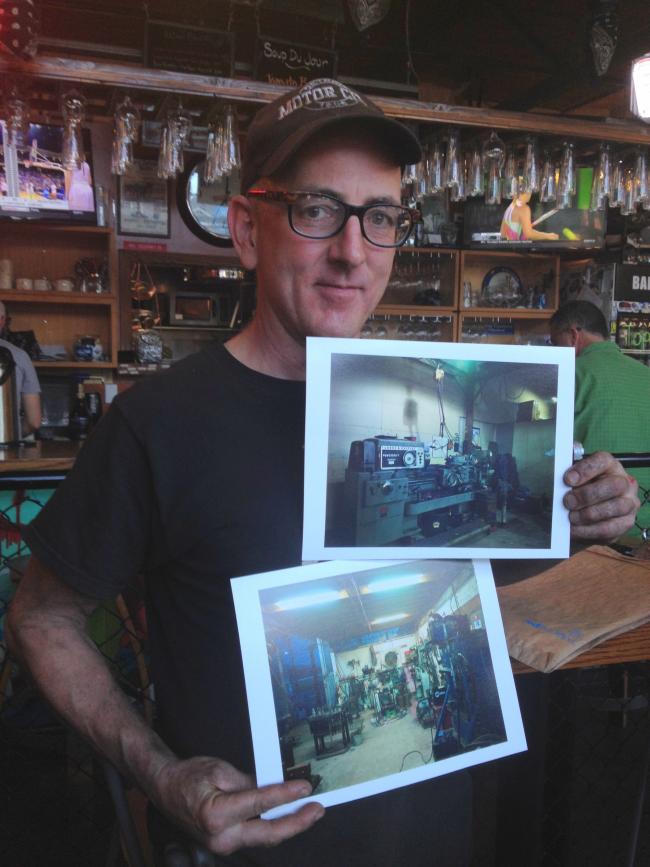At Large in Ballard: By definition to disperse
Steve Howell with Inpanbutr's photos.
Wed, 04/13/2016
By Peggy Sturdivant
Throughout the entire month of March there was always at least one truck being loaded at the Fenpro building on Market Street as its warren of artists and fabricators emptied their studios and prepared to disperse. Until the eve of its last act the final inhabitants were largely invisible, and always impossible to categorize.
On the last official night, when there was supposed to be farewell party that had been nixed by the building manager, the 7 p.m. light was golden, yet eerie. Perhaps it too was dispersing, separating into “constituent wavelengths.” It was March 31st and the leonine artisans of Fenpro were departing like lambs. It was too quiet, too calm, as these artists who had been able to make noise with their welding and soldering, their hammering and drilling, were quietly emptying their workspaces.
At Kiss Café photographers Tod Gangler and Abby Inpanbutr were holding court with another artist while Jay Craig checked the sidewalk for those who were looking for the canceled party. Inpanbutr has been documenting the Fenpro for the last three years, just as Gangler has been documenting vanishing Ballard. The party was going to feature her photographs dry-mounted and suspended throughout empty studios. Instead the photographs were affixed along the Market Street exterior wall, creating an outdoor retrospective of the mysterious inner workings.
Inpanbutr had copies of her photographs that she’d printed at Art and Soul to give to the artists. “Her boss doesn’t pay her enough,” her boss Tod Gangler said, explaining her prints for distribution. Inpanbutr has studied architecture and photography and works in the tri-color process that is most like that of original French photographers. Like Gangler her works have a dimension that reveals what you didn’t know was there. Of course that applies to most of artisans slowly and quietly packing their way out of the Fenpro building.
The end has been a long time in coming. The Nordic Heritage Museum acquired the property in stages as they designed and raised funds to build their new location, having long ago been turned down in their bid to acquire the former Webster School. Now Seattle Public Schools wants to reclaim Webster. It’s like dominoes as the 70+ artists leave their studios, Nordic prepares to break ground and move, and SPS prepares to renovate and return to Webster: a cascade of displacements.
Many nurture hopes that in its own space the Nordic Heritage Museum will be able to incorporate documentation of the history-in-the-making work of these last major blocks of industrial studios. It’s no coincidence that the Scandinavian roots of Ballard, its loggers, fishermen and foundry workers gave way to studio spaces where surgeons made boats, mechanics worked on Volvos and Norwegians did woodwork. Just as Ballard’s original working class settlers would no longer be able to afford to live here, so too the community of artisans is being separated.
There’s no demolition permit yet for the Fenpro but there is a plan to capture its history before it becomes abandoned building, barren block, and finally a gleaming modern museum. Former Fenpro tenants Jay Craig and Abby Inpanbutr have applied for a King County 4Culture grant in order to match her photo documentation with oral histories and written records.
From shipyard to munitions work, to highway signs, the original Fentron has its own legacy. Since Fenpro ceased operations its tenant’s products are worldwide and varied…public art in Alaska, pedestrian bridges, parts in the airplanes overhead, cabinets in ship galleys, museum pieces, and the iron railing that now borders the stairs to my front porch.
The photographer Abby Inpanbutr has spent the past several years documenting Seattle’s maritime industry, with Fenpro’s waterfront location a natural extension. She completed two phases of the documentary project, Persistent Work, with the help of 4culture grants. The first part of Persistent Work was presented at The Center for Wooden Boats, and the second part was shown at the 4culture gallery in May 2014. Inpanbutr also completed a project, Highliners, Boats of the Century, documenting Seattle’s historic halibut fleet. The Highliners project received funding from 4culture, and a second phase to make a survey book of the schooner fleet has also received funding, and is currently underway. The Fenpro project has been discussed with Nordic Heritage Museum and has strong support from Ballard Historical Society.
On the last official night, in golden light, passersby and tenants were looking at the photographs that spanned a city block and the last 15 years. It’s a record of Fenpro’s last act and its most collaborative community. Its grey industrial walls will fall and the Nordic Heritage Museum plans to rise in glass and natural light. It will continue to celebrate all things Scandinavian, and I hope honor Ballard’s Fenpro, one photograph and oral history at a time…with the help of a King County 4Culture grant.


